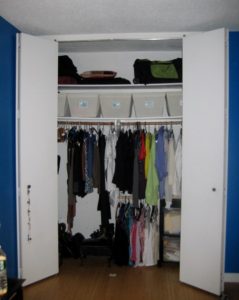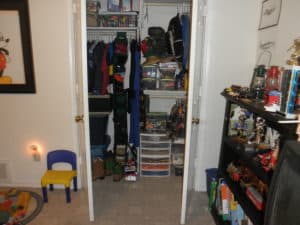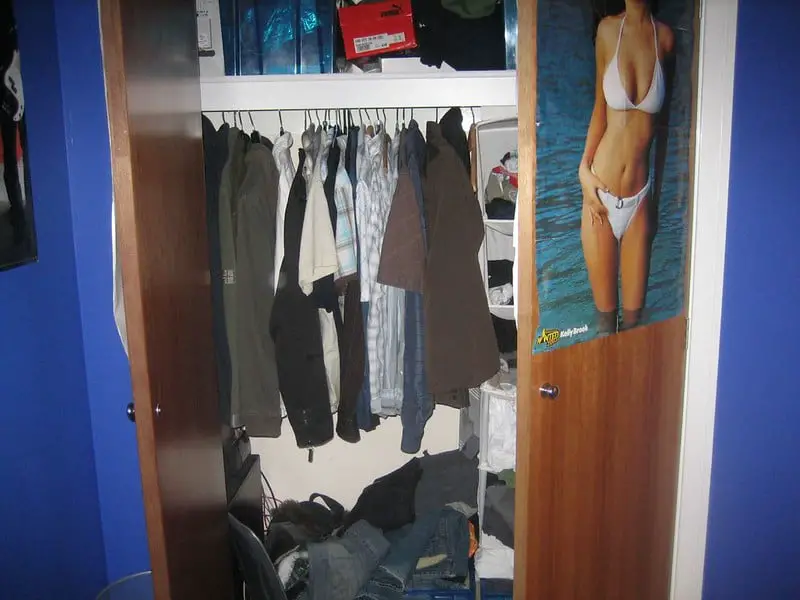Are your bedroom closets cold? Closets get cold for several reasons.
Primarily, bedroom closets get chilled because they are not well insulated or not insulated altogether. Cold closets can wreak havoc if not treated seriously.
Regardless of why your bedroom closets are getting chilled, the biggest threat is the formation of frost then mold.
Whether you like it or not, winter will come and stick around for a considerably longer time. For this reason, you need to keep your bedroom closets insulated to stay warmer in winter.
Your bedroom closet may get colder than usual if there is no air circulation, especially when installed on an exterior wall.
Basically, bedroom closets, and any other storage area for that matter, should have ducts provide ideal air circulation.
With that said, how do you insulate a cold bedroom closet in your manufactured home?
What else can you do to keep your bedroom closets warm in cold weather?
This article will introduce to you everything you need to know about insulating closets and keeping them warm throughout the year. Keep reading.
Why Are Your Bedroom Closets Cold?

Have you had the unfortunate experience of opening your bedroom closet, grabbing your outfit for a function only to find it is cold?
What else could be frustrating than this?
If your bedroom closets have little to no insulation, it is likely that they will be freezing through the winter.
Basically, there are two reasons why bedroom closets in a manufactured home get chilled during winter.
1. Uninsulated Exterior Wall
If your closets are installed on an uninsulated exterior wall, it is a no-brainer that they will freeze during cold weather. The chances are that the coldness may spread into your bedroom; therefore, resulting in an unwelcome chill.
2. Bedroom closets barely have a duct to supply air
Air gaps under your closet door facilitate air circulation, which is ideal and helps keep your closet interior warm.
If your closets are insulated and have air supply vents, it is likely there are other reasons.
During the winter, the heat generated by the heating system may be directed to other places; therefore, leaving your closets cold.
This is probably because the vents are not wide open. If this is the case, you may need to open the closet door partially.
Effects of cold bedroom closets
The biggest threat of cold bedroom closets is the growth of molds.
Both dampness and molds can be a health risk and significantly contribute to respiratory problems.
Because winter sticks around for longer, the coldness in your closets can spread to the entire room.
Living in a cold environment can be problematic and psychologically stressful for the aged, sick, and young.
If you let your cold bedroom closet stay unaddressed, you will likely find most of your clothes cold every morning. Wearing cold clothes will increase your chances of getting acne on the skin.
Note that mold growth tends to worsen when your bedroom closet is poorly ventilated.
Although most molds are less harmful to health, there are some species that release potentially toxic substances; therefore, causing adverse reactions.
It is advisable to insulate your bedroom closets and keep them ventilated to be on the safest side.
People with pre-existing respiratory issues are likely to suffer most if they don’t insulate and ventilate their bedroom closets.
Why Should You Insulate Your Bedroom Closet?
Your bedroom closet is probably the first place you enter every morning.
It annoys when you open your bedroom closet only to meet a very cold breeze.
Ideally, the primary reason you need to insulate your closet is to keep it warm enough during winter.
Insulating reduces the amount of heat escaping your bedroom closet’s interior.
There are several practical benefits of installing insulation in your bedroom closets.
Regardless of how harsh is the cold or sweltering is the heat, you will enjoy the following:
- Ultimate moisture controls
- Insulating is a great way to go green in addition to increasing the comfort in your closet and the entire home.
- Properly installed insulation absorbs noise. Most are excellent sound absorbers.
- Insulating can significantly lower your energy bills.
- Insulation suppresses the growth of molds that can be potentially toxic.
- Insulation improves the quality of indoor air.
- Insulation is a thermal barrier. Although insulations are credited for their ultimate benefits during the cold months, they also keep the rooms more relaxed during summer. Basically, they ensure the heat or cold coming from your HVAC system remains indoors.
How To Insulate Your Bedroom Closet

Now you understand the benefits of insulating a bedroom closet and how it can be hazardous to overlook the issue.
So, where do you start for you to insulate your wardrobe properly? To insulate your cold bedroom closet, the first step is usually to identify where the cold comes from.
Basically, touching the walls will tell you the exact source of coldness. Make sure also to touch the floor and feel how cold it is. All the sides that feel uncomfortably cold need to be insulated immediately.
Cold in bedroom closets, especially during winter, comes from an outside wall.
However, cold can also come from the floors or ceiling. For this reason, proper inspection is necessary as it will help insulate all the sides through which cold enters your closet.
Nevertheless, insulating the exterior wall, closet walls, ceiling, and floor will result in fantastic insulative value.
To resolve the uncomfortable state of having a cold bedroom closet, let’s explore insulating various closet sides.
1. Exterior Wall Insulating
Many people prefer to rip out the drywall, insulate, then hang and finish the drywall.
Although hanging and finishing drywall is easy and does not require special skills, removing it is not the best idea.
You can still insulate your exterior walls without removing the drywall. Indeed, insulating manufactured home walls from outside is one of the easiest ways to retro-fit insulation.
If you are ready to incur the cost of installing new drywall, it will be the best.
Removing the drywall will allow you to install an airtight and vapor barrier to provide optimal efficiency.
If you don’t want to remove the drywall, injecting spray foam is the way to go. This is how to do it.
Step 1: Drill holes in the wall
- Find all the studs on the wall using a high-quality stud finder and mark them using a pencil.
- Drill small holes 1 to 2 inches in diameter between every pair of studs.
- The holes should be drilled at the top of the wall, so insulation naturally piles up and creates an even layer.
Step 2: Blow the insulation into cavities
- Inject cellulose or spray foam into the cavities using a hose until they are filled.
- It is apparent that there are no windows on the outside wall where your bedroom closets are designed.
- If you are injecting insulation into all exterior walls, you will need to check for any obstruction.
- Depending on the obstructions, you will choose whether to blow from the top or bottom.
- Make sure to wear the right protective gear.
Step 3: Sealing and painting
- After filling all cavities, you will need to patch the installation holes.
- Replace the cutouts, fill with wood filler, and allow it to dry.
- After all the holes are patched and dry, sand smooth, and paint to restore your manufactured home siding.
Spray foam is increasingly gaining popularity.
It is a poly material that is sprayed as a liquid then expands once it gets into contact with the air.
Despite its soft fluffy appearance, spray foam has a considerably higher R-value.
One of the amazing benefits of spray foam is that it expands appropriately to fill crevices, leaving no air spaces.
2. Closet Floor Insulating
If the floor of your bedroom closet is uncomfortably cold, you need to insulate it.
Fortunately, insulating a manufactured home floor is one of the easiest things, especially if you are a savvy DIYer.
Even a simple carpet acts as an insulation and can do if the floor is not too cold.
However, it is good to use insulation if you want to benefit the most.
Here are the steps to insulate the closet floor:
Step 1: Preparation
- You will want to optimize the crawlspace.
- Prepare the space by removing the fabric road barrier that protects the manufactured home underbelly during protection.
- After removing it, turn off the water supply and off the electricity to prevent possible electrocuting.
Step 2: Cover water pipes and seal any gaps.
- Cover all water pipes with foam pipe insulation and secure tightly against the floor.
- This will ensure you don’t hassle when insulating because the insulation must cover the lines.
- If there are any air gaps, seal them with high-quality caulk.
Step 3: Installing the insulation
- For underfloor insulation, fiberglass insulation is the most preferred insulation material.
- They are easy to install and provide relatively higher R-value. Greater R-value means a more effective insulant value.
- Fill all the cavities with unfaced batts with the paper facing the ground.
- Attach wires to joists to tightly secure the insulation and provide optimal support.
- If there are any crevices that are not well filled, use spray foam to fill them.
Step 4: Re-install the road barrier.
- Re-attach the fabric road barrier to lower the risks of condensation and freezing.
- If the fabric barrier is seriously damaged, you will want to replace it to provide an ultimate solution.
3. Closet Ceiling Insulating
It is possible the cold in your bedroom closet comes from the attic.
For this reason, you will want to insulate the ceiling.
Here is how to do it. As with the floor, fiberglass insulation is also a suitable material to insulate your ceiling for optimal energy efficiency.
Here are the steps you need to follow.
Step 1: Measuring Up
- The first step is to measure the area you want to insulate.
- Measure the distance between joists and ensure you measure all spaces.
- The standard width between joists is 24 inches.
- Roughly determine the area you want to insulate.
- Basically, this is the area above your bedroom closet unless you want to insulate the entire ceiling.
- You will also want to determine the R-value needed – R-value may be specified by code.
- The higher the R-value, the better the insulation.
Step 2: Prepare to install the insulation
- You will find wires running on the ceiling in almost every home.
- Therefore, to be safe, you will need to switch off the electricity before starting installation.
- It is also a good idea to check if your ceiling is strong to withstand insulation weight.
- You will barely find plumbing lines passing over the bedroom closet.
Step 3: Install the insulation
- When installing the insulation, you start with filling the spaces between joists.
- Pre-cut the batts into ideal sizes and tuck them into cavities without compressing them.
- Compressing fiberglass insulation reduces its efficiency.
- Fit the basts snugly between all joists onto the ceiling plaster.
- After filling between joists, add a second layer with unfaced insulation to cover the joists entirely.
- When installing the insulation, make sure to be keen on recessed lighting.
- Unless fixtures are insulation-contact (IC) rated, keep insulation at least 3 inches from them.
4. Closet Wall Insulating
As mentioned earlier, closet coldness is likely to come from an outside wall.
However, installing insulation on your walls will ensure that the closet retains maximum heat.
The recommended R-value for closet walls is R-1; however, there is no harm in making it higher.
Higher R-value only ensures the resultant insulative value is impressive.
For bedroom closet walls, you can use unfaced insulation as it works the best.
- Because you don’t want to lose any closet depth, it will be better when injected foam is used.
- The process of blowing insulation into closet wall cavities is like that of insulating an outside wall.
- Locate all studs and cut small holes between every two adjacent studs. The holes should be closer to the ceiling as possible.
- Inject the spray foam into the holes until the cavities are filled. You will need to lay sheets on the floor to make cleaning easy.
- Seal the installation holes, sand smooth, then paint to give your bedroom interior its original elegant look.
After insulating every surface of your bedroom closet, you are sure to enjoy the rest of your time with a warmer closet.
With proper insulation, your bedroom closet will have ideal temperatures all year round. Make sure to seal all edges appropriately.
What Should You Do If The Closet Is STILL GETTING COLD?
If you are living in an extremely cold climate, you might find your bedroom closet is cold even when it is insulated.
We all know that insulating walls is the ultimate way to optimize energy efficiency in your home.
Although the recommended R-value for a bedroom closet wall is R-11, it will be better if you made it higher.
For people in icy conditions, installing insulation with R-30 can work better, and it won’t cost that much more than the R-11.
If things seem not to work, you can work on the venting. Ideally, you will have to vent your closet properly to facilitate air circulation.
If the heat from your HVAC system is not reaching the closet, you might consider leaving it partially open. This is because closet doors can block heat.
The ultimate solution if your insulated bedroom closet is still getting cold, is adding a heat source.
Apparently, you will face two significant problems
- lack of spaces
- and few freestanding walls.
For this reason, the best source of heat is underfloor heating. However, heating bedroom closets you risk fire hazards; therefore, you will want to eliminate heaters that get overly hot.
Underfloor Heating Pros
- It is a superior and efficient method of heating your bedroom closet.
- Most underfloor heat sources do not get overly hot. Basically, hot water pipes are the common sources of heat in bedroom closets. They are easy to install and take little to no space.
- Underfloor heating ensures that heat is distributed evenly. As a result, you will never get disappointed to pick a cloth in the morning only to find it is cold.
Underfloor Heating Pros
- It is an expensive way to heat your bedroom closet. The upfront costs of installing underfloor heating are usually high.
- Underfloor heating takes too long to warm up. This might upset you, especially if you are in a hurry.
Conclusion
Making your cold bedroom closet warmer is not one of the hardest things.
All you need is to install insulation having a higher R-value.
If you are a savvy DIYer, you will find the entire process of installing insulation simple.
Insulating your bedroom brings more comfort to your bedroom, and it is also an easy way to go green.
Insulating the closet will eliminate all disappointments that may result from finding your clothes cold.

